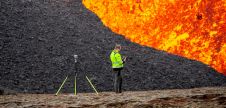做你自己的地理
Conferences have changed. That’s what I concluded after June’s GSDI conference in Rotterdam. It’s all about multimedia. Scientific presentations today are always in PowerPoint and come with integrated video clips; company presentations are flashy movies accompanied by music and humour. On the retrieving end things have changed even more. The GSDI INSPIRE day could be followed live on the internet. And the event set a record for the conference centre – never had so many people been connected wirelessly to the internet at the same time. Surfers included those taking a break after presentations, and also people sitting in the audience and sharing their impressions with the rest of the world – on their blogs or via Twitter – throughout the presen-tations. And don’t think you can attend a conference without being noticed; everybody takes photos, putting them on Flickr and other photo sharing sites. Or you could get “Flipped’ by a reporter making short video interviews with a Flip camcorder, and then publishing them on YouTube. An overview can be found in our GSDI report.
随着会议在荷兰,许多荷兰人的“英雄”走向了舞台。JRC的Leen Howdijk关于利用新的机会。每天,从欧洲 - 海运联盟卫星检索250张高分辨率图像。在2008年,1.18亿人的移动手机在全球之中销售,其中大多数都能够做定位的搜索。地理浏览器用作社区的平台形式,以分享地理标记信息,开辟合伙人的机会,以补充“官方”信息服务。作为公民赋权的一个例子,Hordijk与观众共享非常成功的荷兰自然日历('Natuurkalender')。在这个网站上,自愿观察员张贴有关他们发现的新鸟类,蝴蝶和植物的信息。由于参与者数量惊人,如果有人对一些稀有物种犯了一个黑鹂,那么帖子很快就会过滤出来。
用户生成的地理空间内容通常被称为Neo-Geography,字面上“新的地理图”。它包含了诸如OpenStreetMap等数据的主动集合,以及诸如Flickr标签的用户数据的被动集合。但是,关于网络映射,地理和GIS字段中新地理的范围和应用存在争论。有些人认为地理是一个成熟的科学学科,而谷歌地球上的混碎和标签不是;他们更喜欢志愿志愿的地理信息。
HORDIJK向观众询问了“DO-IT-SWINE”的映射应用程序真的没有对科学价值,提到互联网网站的开发人员因观察结果而获得博士学位。新地理学的另一个正面是社交网络的构建,具有自下而上的方法,用户成为信息的生产者。这与GSDI会议形成对比,其中大多数空间数据基础架构(SDI)的特征在于以上,数据生产者 - 所有者的方法。

























